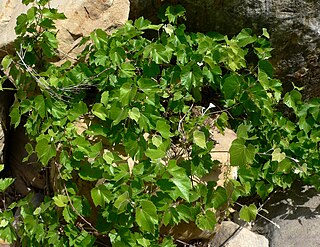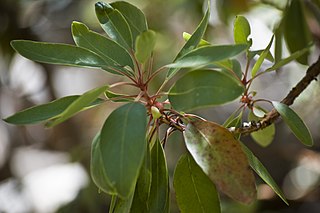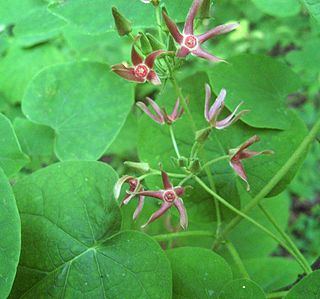
Pima County is a county in the south central region of the U.S. state of Arizona. As of the 2010 census, the population was 980,263, making it Arizona's second-most populous county. The county seat is Tucson, where nearly all of the population is centered. The county is named after the Pima Native Americans who are indigenous to this area.

Cupressus arizonica, the Arizona cypress, is a North American species of trees in the cypress family. It is native to the southwestern United States, and in Mexico. In the wild, the species is often found in small, scattered populations, not necessarily in large forests. An example occurrence is within the Sierra Juárez and San Pedro Mártir pine-oak forests of Mexico, where it is found along with canyon live oak and California fan palm.

The Rincon Mountains are a significant mountain range east of Tucson, Pima County, Arizona, in the United States. The Rincon Mountains are one of five mountain ranges surrounding the Tucson valley. The other ranges include the most prominent, the Santa Catalina Mountains to the north, the Santa Rita Mountains to the south, the Tucson Mountains to the west, and the Tortolita Mountains to the northwest. Redington Pass separates the Rincon Mountains from the Santa Catalina Mountains. The Rincon Mountains are generally less rugged than the Santa Catalina Mountains and Santa Rita Mountains. The Rincon Mountains are also included in the Madrean sky island mountain ranges of southeast Arizona, extreme southwest New Mexico, and northern Sonora Mexico.

Cirsium arizonicum, the Arizona thistle, is a North American species of thistle in the sunflower family, native to the southwestern United States and northwestern Mexico. It has been found in Arizona, southeastern California, New Mexico, Nevada, Colorado, Utah, Sonora, and northwestern Chihuahua.

Gonolobus is a genus of plant in family Apocynaceae, first described in 1803. It is native to South America, Central America, Mexico, the West Indies, and the southern United States.

Matelea is a genus of flowering plants in the family Apocynaceae. It contains about 200 species, which are commonly known as milkvines.

Vincetoxicum is a genus of plant in family Apocynaceae. Although the species in Vincetoxicum have sometimes been included in Cynanchum, chemical and molecular evidence shows that Vincetoxicum is more closely related to Tylophora.
Parthenice is a genus of flowering plants in the sunflower family.

The Waterman Mountains are a low mountainous landform in Pima County, United States. Notable among the tree species is the elephant tree which species exhibits a contorted multi-furcate architecture; most of these froze in the cold winter of 2011. The Waterman Mountain range is in the Ironwood Forest National Monument.

Vitis arizonica is a North American species of wild grape. It is a deciduous vine.

Arbutus arizonica, commonly known as Arizona madrone, is a tree species in the heath family that is native to the southwestern United States and northwestern Mexico. Its range extends along the Sierra Madre Occidental cordillera from the Madrean Sky Islands of southeastern Arizona and southwestern New Mexico south as far as Jalisco. It has been found in Sonora, Chihuahua, Durango, and Sinaloa, with one isolated population in Tamaulipas.
Gaillardia arizonica, the Arizonia blanketflower, is a species of flowering plant in the sunflower family. It is native to northwestern Mexico (Sonora) and the southwestern United States.
Grindelia arizonica, Arizona gumweed, is a North American species of flowering plants in the daisy family. It is native to the southwestern United States and northern Mexico, in the States of Coahuila, Chihuahua, Arizona, New Mexico, Utah, Texas, and Colorado.
Gutierrezia arizonica is a North American species of flowering plant in the daisy family known by the common name Arizona snakeweed. It is native to Arizona in the United States and Sonora in northwestern Mexico.

Matelea obliqua, commonly known as climbing milkvine, limerock milkvine or northern spinypod, is a species of flowering plant in the dogbane family. It a twining herbaceous vine that produces maroon flowers in summer.

Matelea reticulata, commonly called netted milkvine, is a species of flowering plant in the dogbane family (Apocynaceae). It is native North America, where it is endemic to the U.S. state of Texas. Its natural habitat is in thickets on rocky hillsides.

Matelea cynanchoides, commonly called prairie milkvine, is a species of plant in the dogbane family that is native to south-central United States.












